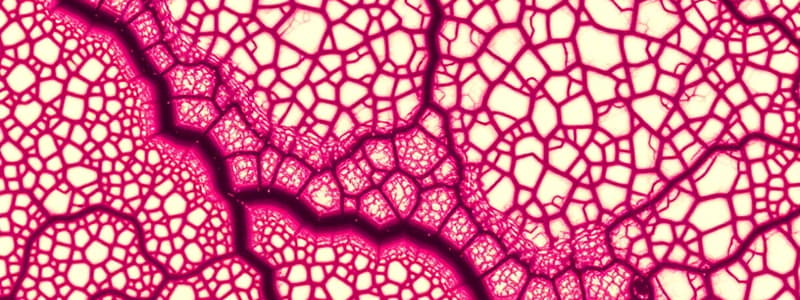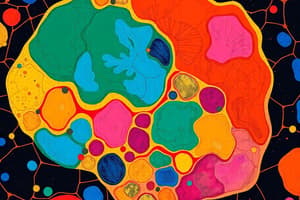Podcast
Questions and Answers
Which type of connective tissue is characterized by a high number of cells compared to fibers?
Which type of connective tissue is characterized by a high number of cells compared to fibers?
- Dense regular connective tissue
- Loose connective tissue (correct)
- Reticular connective tissue
- Elastic connective tissue
What is the primary structure of dense irregular connective tissue?
What is the primary structure of dense irregular connective tissue?
- Mucoid matrix
- Regularly arranged collagenous bundles
- Irregularly arranged collagenous bundles (correct)
- Aloof elastic fibers
Which connective tissue provides flexibility and resists stress in tendons?
Which connective tissue provides flexibility and resists stress in tendons?
- Loose connective tissue
- Reticular connective tissue
- Elastic connective tissue
- Dense regular connective tissue (correct)
What type of tissue is primarily composed of yellow elastic fibers?
What type of tissue is primarily composed of yellow elastic fibers?
Which connective tissue type is primarily located in the sclera of the eye and the capsule of organs?
Which connective tissue type is primarily located in the sclera of the eye and the capsule of organs?
Where is loose connective tissue primarily found?
Where is loose connective tissue primarily found?
What type of dense connective tissue contains collagenous fibers arranged in parallel?
What type of dense connective tissue contains collagenous fibers arranged in parallel?
What is a characteristic feature of mucoid connective tissue?
What is a characteristic feature of mucoid connective tissue?
Which structure is predominantly present in elastic connective tissue?
Which structure is predominantly present in elastic connective tissue?
Which specific location is associated with dense regular connective tissue?
Which specific location is associated with dense regular connective tissue?
Which connective tissue is primarily responsible for giving elasticity to the tissue?
Which connective tissue is primarily responsible for giving elasticity to the tissue?
In which locations is mucoid connective tissue typically found?
In which locations is mucoid connective tissue typically found?
What type of adipose connective tissue is predominantly present in adults?
What type of adipose connective tissue is predominantly present in adults?
What structure distinguishes brown adipose connective tissue from white adipose connective tissue?
What structure distinguishes brown adipose connective tissue from white adipose connective tissue?
Which connective tissue is characterized by its network of reticular cells and fibers?
Which connective tissue is characterized by its network of reticular cells and fibers?
What major function is associated with brown adipose connective tissue?
What major function is associated with brown adipose connective tissue?
What is a primary feature of white adipose tissue?
What is a primary feature of white adipose tissue?
What chemical components are abundant in the matrix of mucoid connective tissue?
What chemical components are abundant in the matrix of mucoid connective tissue?
Where is brown adipose connective tissue most commonly found?
Where is brown adipose connective tissue most commonly found?
Which of the following is NOT a function of white adipose connective tissue?
Which of the following is NOT a function of white adipose connective tissue?
Flashcards are hidden until you start studying
Study Notes
Types of Connective Tissue
- Connective tissue is a diverse type of tissue with a wide range of functions in the body.
- It is classified into several types:
- Connective Tissue Proper: This category includes loose and dense connective tissue.
- Specialized Connective Tissue: This group includes adipose (fat), reticular, cartilage, bone and hemopoietic tissue.
- Supporting Connective Tissue: This category includes cartilage and bone.
Loose Connective Tissue (Loose Areolar Tissue)
- This tissue is very common throughout the body.
- It features a variety of cells and fibers, with a higher concentration of cells compared to fibers.
- Functions:
- Supports epithelial tissue.
- Its flexibility and vascularity make it well-suited for various functions, including wound healing.
- Locations:
- Lamina propria and submucosa of different tracts (respiratory, gastrointestinal, urinary, etc.).
- Hypodermis (layer beneath the skin).
Dense Connective Tissue
- Characteristics: Characterized by a high concentration of collagen fibers and a relatively lower number of cells and matrix.
- This type of connective tissue is stronger and less flexible than loose connective tissue.
- Types:
- Dense Regular Connective Tissue: Features parallel, organized collagen bundles.
- Locations: Tendons (connecting muscle to bone), cornea of the eye.
- Dense Irregular Connective Tissue: Displays a more irregular arrangement of collagen bundles.
- Locations: Sclera of the eye, capsules of organs, dermis of the skin, outer fibrous layer of periosteum and perichondrium.
- Dense Regular Connective Tissue: Features parallel, organized collagen bundles.
Specialized Connective Tissue
-
Adipose Connective Tissue:
- White Adipose Tissue (Unilocular):
- Predominant form in adults.
- Located in subcutaneous tissue, around organs, and in other sites.
- Composed of large, spherical adipocytes containing a single large fat globule, pushing the nucleus to the periphery (signet ring appearance).
- Functions: Energy storage, insulation, body contour, and support for some organs.
- Brown Adipose Tissue (Multilocular):
- More prominent in newborns and less abundant in adults, found in mediastinum and between the scapulae.
- Contains smaller, more numerous adipocytes with multiple fat droplets.
- Features numerous mitochondria and has a greater blood supply than white adipose tissue.
- Function: Rapid heat production in response to cold temperatures.
- White Adipose Tissue (Unilocular):
-
Reticular Connective Tissue:
- Found in the stroma of parenchymatous organs (liver, spleen, lymph nodes, bone marrow).
- Composed of reticular cells and reticular fibers, forming a network.
- Function: Provides structural support for these organs.
-
Mucoid Connective Tissue:
- Found in the umbilical cord, pulp of young teeth, and vitreous humor of the eye.
- Features a soft matrix rich in mucin and hyaluronic acid.
- Consists of young fibroblasts that intercommunicate through long processes.
- Function: Provides structural support.
-
Elastic Connective Tissue:
- Also called yellow elastic tissue, this tissue is found in arteries, true vocal cords, ligaments of the vertebral column.
- Contains abundant elastic fibers alongside fibroblasts.
- Function: Provides elasticity to these structures.
Studying That Suits You
Use AI to generate personalized quizzes and flashcards to suit your learning preferences.




